
Daily Market Analysis and Forex News
2024 US elections: Final market predictions
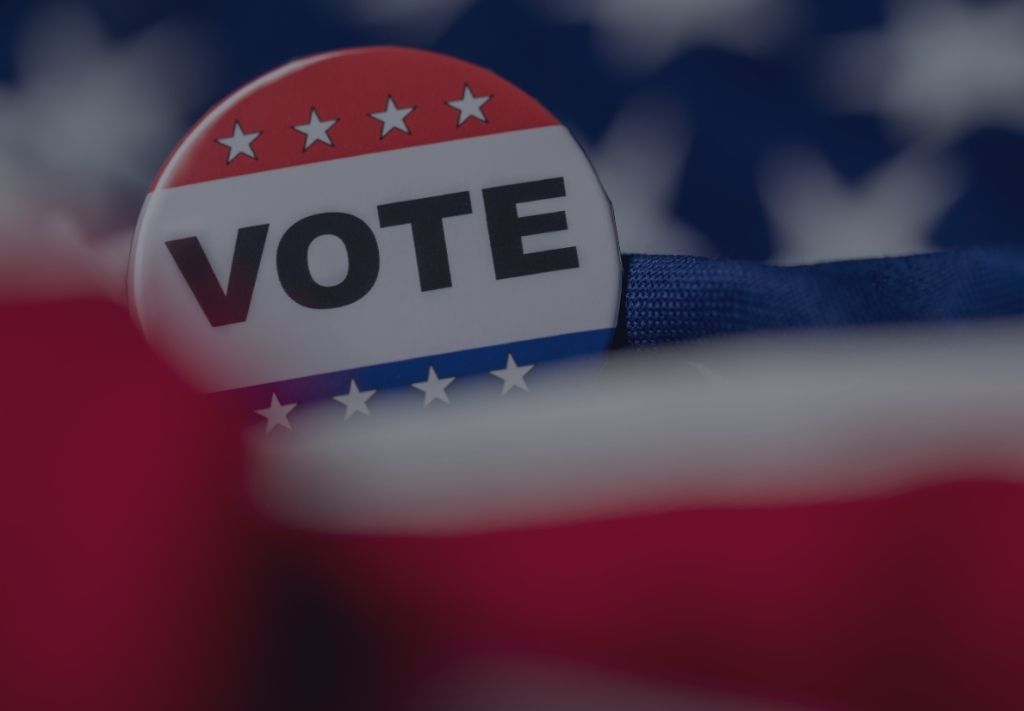
As the 2024 US election draws near, Americans still appear divided on their choice of candidate, with no clear forerunner emerging between Democrat Kamala Harris and Republican Donald Trump.
While the coveted Oval Office position remains unsure until the votes of 5th November are counted, one thing we can be sure of on election day is market volatility. And for smart, prepared traders, volatility means trading opportunities!
In this blog, we reflect on the overall impact of elections on the markets before we explore the two possible outcomes and how they could affect forex, stocks, and other markets. Also, we’ll share some key last-minute tips for traders looking to navigate election day volatility.
Trading markets: Why the US elections matter
The US election is a major political event that can have a dramatic impact on global market performance. Here’s why:
-
Shifts in economic policy: Different administrations often have contrasting approaches to economic policies, including taxation, regulation, and government spending. In turn, this can lead to changes in employment, debt, and inflation, with a knock-on effect in the markets.
-
Changes to trade relations: US trade policies can significantly impact global commerce and currency valuations. Democrats are more open to friendly international relations, where Republicans are more protective and supportive of domestic industry.
-
Sector-specific impacts: Based on the policies and approaches supported by the new President, certain industries may benefit, while others could face challenges.
-
Overall market sentiment: These times of potential change or transition can create uncertainty, which often leads to increased market volatility.
And while no one can predict with absolute certainty how the markets will react, historical market patterns offer us an indication of what may happen around the US elections.
As a trader, you can use this information to prepare your trading strategies ahead of the election while remaining open and adaptable to fluctuations.
The volatility of uncertain markets brings more trading opportunities, but it also brings greater risk. Risk management should be carefully considered and applied to protect your portfolio capital and minimise any potential losses.
US election results and predicted market movements
What happens if Kamala Harris wins?
Predictions for the forex market
Democratic administrations typically increase government spending and focus on creating jobs in the public sector. Historically, with a Democratic win the USD sees some short-term volatility with appreciation over the longer term.
Assuming we see a President Harris, markets expect “policy continuity”, which means most of her policies would reflect those of her predecessor, President Joe Biden. Under President Biden, US inflation has been slowing steadily, enabling the Federal Reserve to lower interest rates.
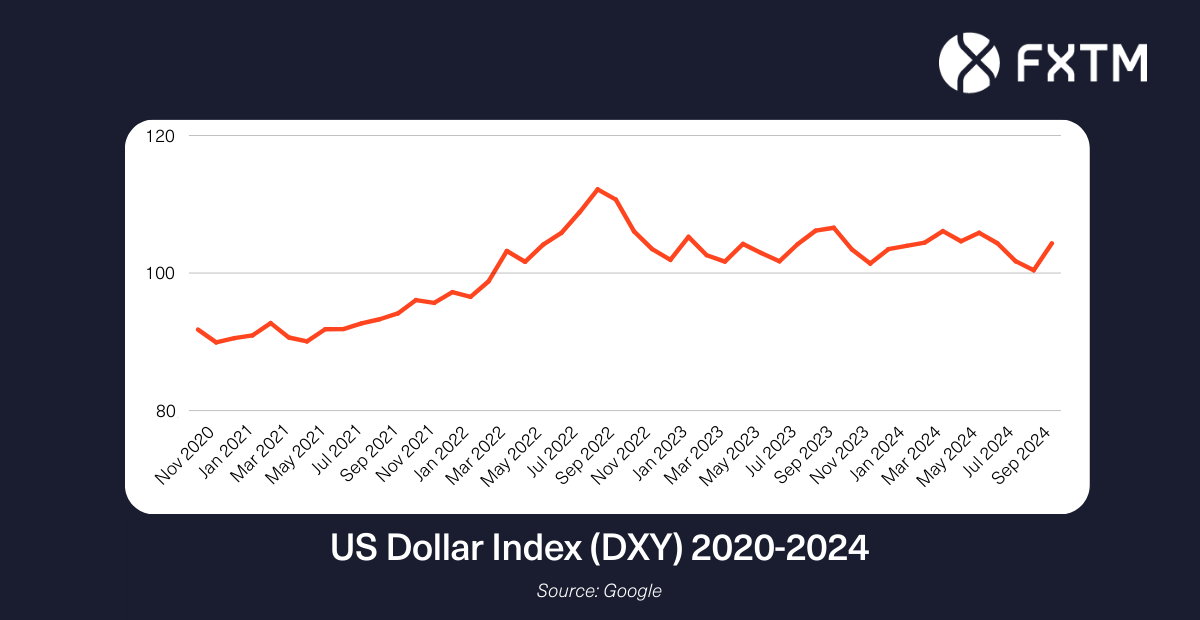
If the incoming administration’s government spending plans don’t disrupt the Fed’s plans to cut interest rates further, the US dollar could resume its declines over the near term.
In addition, a Harris win would significantly lower the risk of global trade tensions. Trade conflicts between the US and major economies tend to stoke fears of a global economic slowdown, which in turn boosts demand for the US dollar, a favoured safe-haven asset.
A lowered risk of global trade tensions may soften the US dollar, while providing relief for currencies of major US trading partners such as the Chinese yuan, the euro, and the Mexican peso.
Predictions for stock and indices markets
A Harris administration is expected to prioritise climate change, infrastructure, healthcare reform, and technology regulation. These policy goals could drive growth in renewable energy, healthcare, and technology sectors.
Clean energy and technology:
The Democratic Party are known for their proactive stance on clean energy. As such, we could see massive investments in renewable energy, electric vehicles (EVs), and climate. Under new green policies, renewable energy stocks and companies focused on climate technology could rally.
-
Renewable energy: Companies involved in solar, wind, and other renewable technologies could see substantial growth. Businesses like First Solar, NextEra Energy, Enphase Energy, and Solaredge Technologies would benefit from increased federal support, tax incentives, and infrastructure spending.
-
Electric vehicles (EVs): EV manufacturers, especially Tesla and Rivian, EV charging station network operators such as ChargePoint Holdings, and battery technology companies like QuantumScape, would likely gain from policies pushing for a transition away from gasoline-powered cars.
Healthcare and pharmaceuticals:
As President, Harris may expand healthcare access and emphasise public health spending. This would benefit companies involved in healthcare infrastructure, medical technology, and public health, particularly those in preventive care and telemedicine.
-
Healthcare providers: Companies like Teladoc and UnitedHealth might benefit from increased access to healthcare, although private insurers could face challenges if major reforms are introduced.
-
Biotech and pharmaceuticals: Companies focused on public health, vaccines, and treatments, for example, Pfizer and Moderna, may gain as more people obtain access to healthcare services.
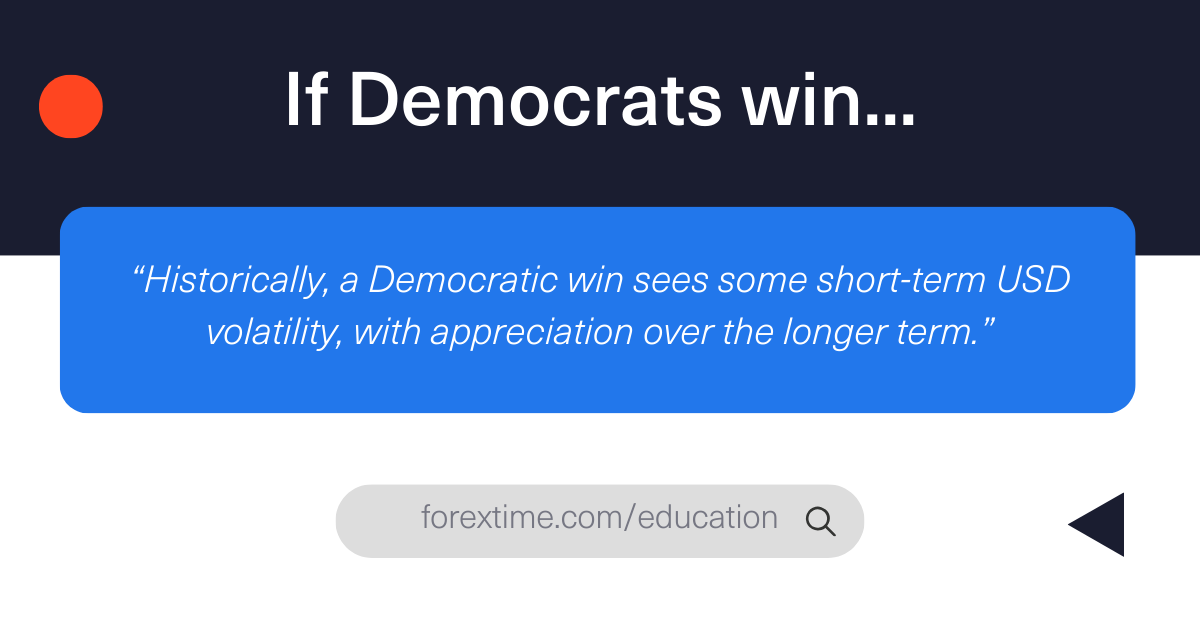
Indices:
S&P 500 (US500)
This broad US market index could see mixed results leaning slightly negative in the short term but turning positive in the long term.
The initial reaction might be cautious if the market fears higher corporate taxes or stricter regulations on industries like energy, healthcare, or big tech. However, sectors tied to clean energy, infrastructure, and technology could see long-term benefits from increased government spending.
If inflation remains under control, these policies may lead to stronger growth in the future.
NASDAQ 100 (NAS100)
The Nasdaq, which is heavily weighted in technology and innovation-driven companies, is likely to benefit under Harris due to her focus on clean technology, climate change, and a push toward innovation in healthcare and infrastructure.
Concerns about tech regulation may linger, but overall, the sector would benefit from favourable policies toward innovation. Big tech, renewable tech, biotech, and digital infrastructure could see gains, particularly as these areas align with her policy goals.
Large tech companies might face regulatory scrutiny or tax hikes, though the impact may be offset by broader industry growth.
Other markets predictions:
-
Gold: Gold could see short-term gains as uncertainty around new policies shakes markets, but its longer-term outlook should strengthen if the Federal Reserve can proceed with its intended rate cuts.
-
Cryptocurrencies: Although considerably more guarded with her views than a vocal Trump, Harris has expressed support for the establishment of a cryptocurrency framework, and as such we could see a lift in the prices of cryptos like Bitcoin.
US election day trader’s checklist
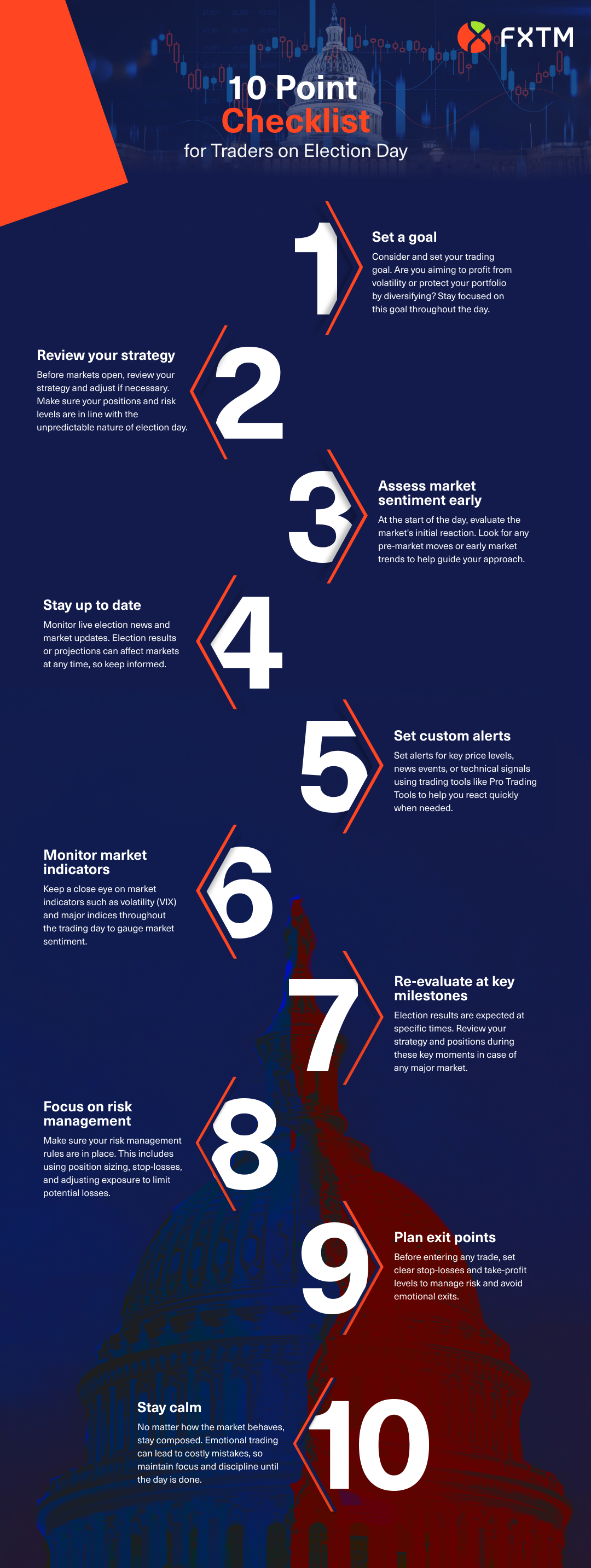
What happens if Donald Trump wins?
Predictions for the forex market
A Trump victory would likely strengthen the US dollar in the short term, driven by expectations of tax cuts, deregulation, and a continued "America First" agenda.
The greater prospects of trade wars under President Trump 2.0 may exert downward pressures on the global economy, as the likes of the China, Eurozone, and Mexico brace for higher tariffs which discourage cross-border trade.
So, should Trump reclaim the White House, the Chinese yuan, euro, and Mexican peso are bound to see a knee-jerk selloff.
As mentioned, greater fears of a slowing global economy can also ramp up demand for safe haven assets, including the US dollar. Note how the US dollar index posted annual gains in 2018 and 2019, at the height of the global trade wars during the previous Trump administration.
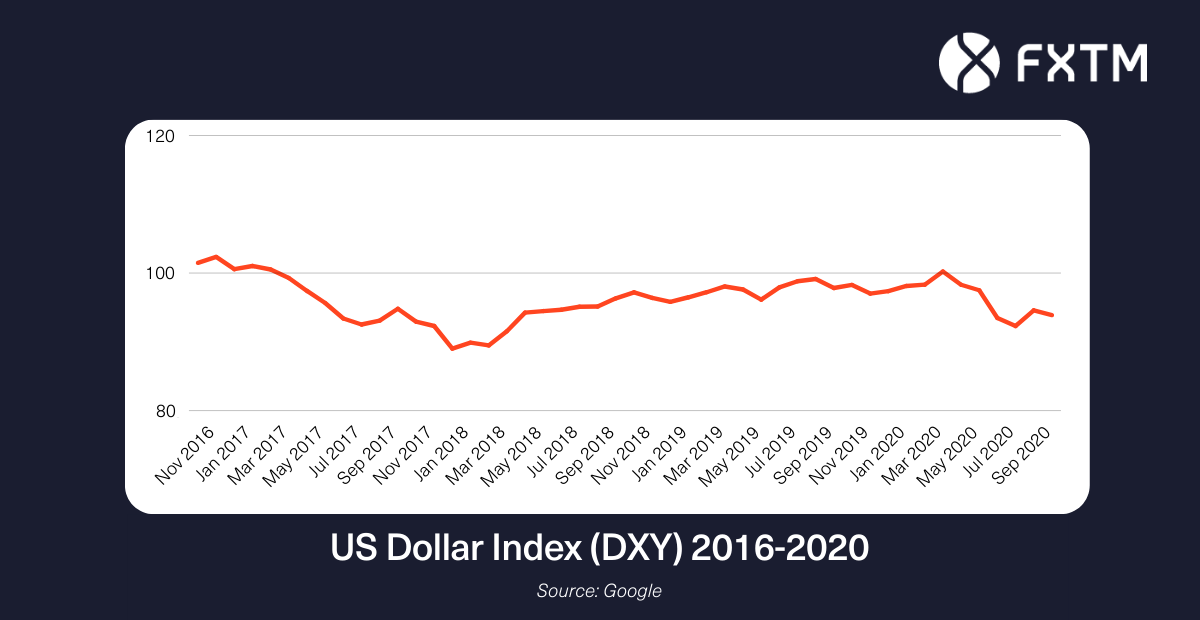
The US dollar could also strengthen under President Trump 2.0, not only because of the external factors mentioned above, but also due to domestic factors.
Trump’s proposed policies aim to encourage domestic spending, which could reignite US inflation. If so, then the Federal Reserve may not be allowed to lower interest rates as intended.
Higher interest rates tend to be accompanied by currency strength. In other words, relatively elevated US interest rates translate into more demand for the US dollar.
Predictions for stock and indices markets
A second Trump term would likely continue to focus on deregulation, tax cuts, and policies favouring traditional energy, defence, and financials. The focus would remain on supporting domestic industries through economic growth, deregulation, and trade policies.
Fossil fuels and traditional energy:
Trump’s policies are typically favourable to the fossil fuel industry, with continued support for oil, natural gas, and coal production. Deregulation and energy independence remain key focuses, which could boost these industries.
-
Oil and gas: Companies like ExxonMobil and Chevron could see gains due to less stringent environmental regulations and expanded oil drilling projects.
-
Fracking and natural gas: Fracking companies like EOG Resources and Devon Energy might benefit from a continuation of pro-fossil fuel policies and increased production opportunities.
Defence and aerospace:
Trump is likely to continue increasing defence spending, supporting military contractors and defence technology companies. His administration has been known to favour a strong military and expand defence budgets.
-
Defence contractors: Companies like Lockheed Martin, Northrop Grumman, and General Dynamics are positioned to benefit from continued defence spending and military expansion.
Financials:
Trump’s administration would likely continue to support deregulation in the financial sector, making it easier for banks to lend, invest, and grow profits. Lower taxes and favourable economic conditions could support bank growth.
-
Banks and financial institutions: Major banks like JPMorgan Chase, Goldman Sachs, and Bank of America would likely benefit from a less-regulated financial environment, tax cuts, and strong economic growth.
Industrial and manufacturing:
Trump’s focus on bringing manufacturing jobs back to the US and prioritising domestic production could benefit the industrial and manufacturing sectors.
-
Manufacturers: Companies like Caterpillar and General Electric may gain from policies supporting domestic production and infrastructure, especially if trade tensions ease.
-
Autos and heavy equipment: Automakers, particularly those producing traditional gas-powered vehicles like Ford and General Motors, could see a boost if Trump continues to favour traditional industries over green energy policies.
Construction and infrastructure:
Trump has consistently spoken about increasing infrastructure spending, particularly on traditional infrastructure like roads and bridges, as well as border security projects.
-
Construction: Companies like Caterpillar and Jacobs Solutions could benefit from increased infrastructure spending and continued investment in projects like roads, highways, and border security.
Indices:
S&P 500 (US500)
Investors will likely favour Trump’s continuation of corporate-friendly policies, including tax cuts and deregulation, which could drive stock prices higher, and mean some positive movement in the short-term.
Over the longer-term though, concerns about US debt and renewed trade tensions could add volatility. Energy (especially fossil fuels), defence, financials, and traditional industrial companies would likely benefit from reduced regulation and continued support for domestic production.
On the other hand, renewable energy and companies that rely heavily on global trade, such as auto and tech, could face challenges, and drag the overall index down.
US stock indices may also fall if markets fear that a second Trump administration may prevent the Fed from cutting interest rates as much as previously expected.
NASDAQ 100 (NAS100)
While Trump’s policies could benefit the tech sector with lower taxes and continued deregulation, ongoing trade tensions with China could hurt tech companies reliant on global supply chains and international sales.
Big tech firms may also face continued scrutiny over monopolistic practices. Domestic-focused tech companies, defence tech, and cybersecurity could see gains from increased government spending and a friendly regulatory environment.
Overall, the outlook for this tech-centric index is a bit mixed, but leans more to higher volatility.
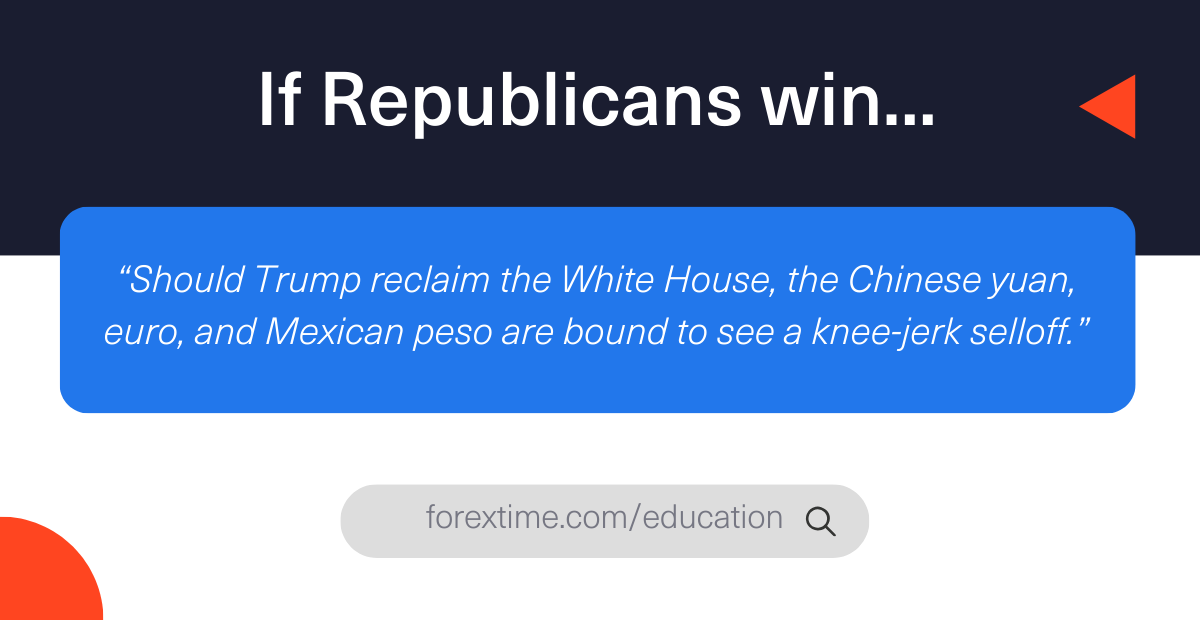
Other markets predictions:
-
Oil: Oil prices could fall as Trump’s policies favour increased energy independence and fossil fuel production. Greater supply, combined with a stronger US dollar, could weigh heavily on the oil price.
-
Cryptocurrencies: In a complete turnaround from previously sceptical comments, Trump’s more recent pro-Bitcoin rhetoric may drive the cryptocurrency prices higher as he promises a more regulatory-friendly environment and his plan to make the US the cryptocurrency hub of the world!
Last minute tips for traders
While these predictions offer potential trading opportunities, it's crucial to remember that markets can be unpredictable. Here are some tips for trading during election periods:
-
Stay informed:
Stay informed throughout election day by following live polling data and news updates. Pre-market and overnight volatility will likely reflect election coverage, so position yourself accordingly.
-
Manage risk:
With markets on edge, risk management is critical. Use stop-losses and position sizing to protect your portfolio from sudden swings.
Don’t overexpose yourself to any single position and stay cautious when reacting to market fluctuations.
-
Diversify:
Spread your investments across multiple asset classes, such as stocks, commodities, and currencies (forex). This reduces your exposure to any single asset class, helping you balance potential losses with gains in other areas.
-
Take advantage of volatility:
Election day brings market swings across multiple asset classes. And while volatility brings more risk, it also presents greater opportunities if you have a plan in place. Set custom price alerts and stop-loss orders to help you react quickly without needing to be glued to your screen.
-
Prepare for post-election reactions, too:
The market’s response doesn’t end on election night. If results are delayed or contested, volatility could extend for days or even weeks. Keep monitoring developments for potential trading opportunities as the election process unfolds.
Bear in mind that this analysis is based on historical patterns and the most current information available at the time. We encourage you to always conduct your own research before making any trading decisions.
Ready to trade with real money?
Open accountChoose your account
Start trading with a leading broker that gives you more.